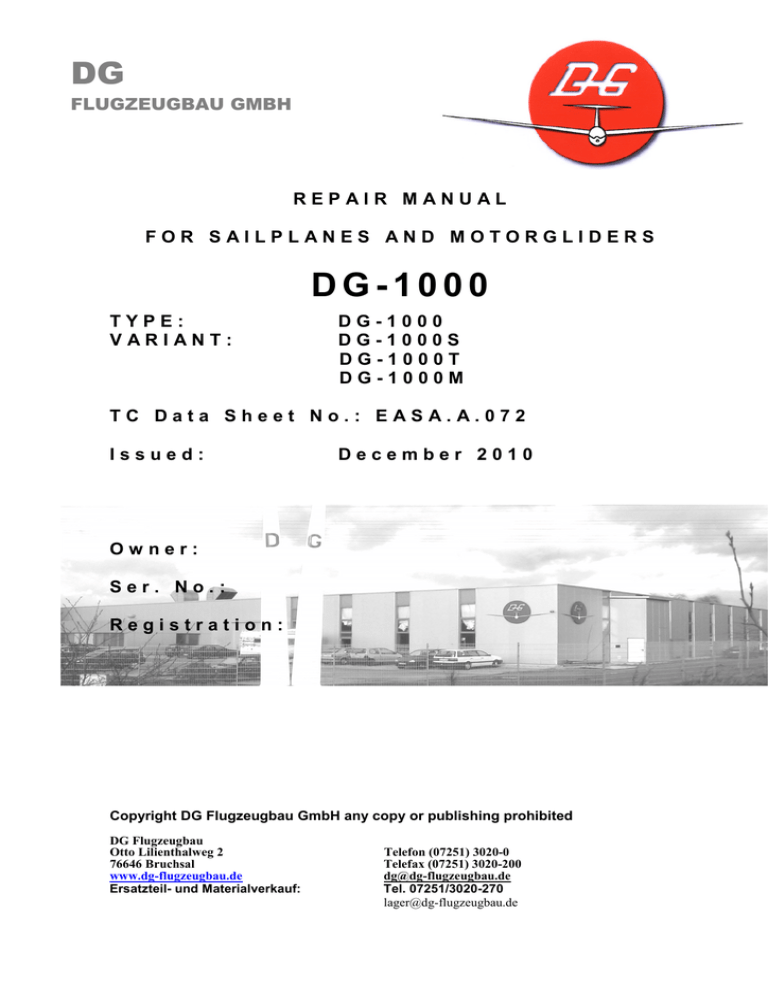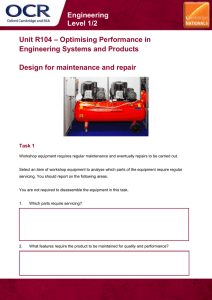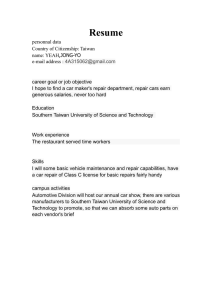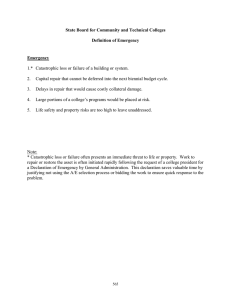DG-1000 - DG Flugzeugbau
advertisement

DG FLUGZEUGBAU GMBH REPAIR MANUAL FOR SAILPLANES AND MOTORGLIDERS DG-1000 TYPE: VARIANT: DG-1000 DG-1000S DG-1000T DG-1000M TC Data Sheet No.: EASA.A.072 Issued: December 2010 Owner: Ser. No.: Registration: Copyright DG Flugzeugbau GmbH any copy or publishing prohibited DG Flugzeugbau Otto Lilienthalweg 2 76646 Bruchsal www.dg-flugzeugbau.de Ersatzteil- und Materialverkauf: Telefon (07251) 3020-0 Telefax (07251) 3020-200 dg@dg-flugzeugbau.de Tel. 07251/3020-270 lager@dg-flugzeugbau.de Repair manual DG-1000 0 General 0.1 Amendments No. Page Description Date 1 all December 2000 2 2.1, 4.1 – 4.3, 5.1, 5.3, 6.3 3 0.1, 0.2, 1.1, 2.1, 3.1, 4.1, 5.1 Combination of the initial repair manuals of the Variants DG-1000S and DG-1000T, inclusion of variant DG-1000M, new standardized format Miscellaneous changes to the contents of the latest amendments of the initial repair manuals Manual revision Issued: October 2012 Revision 3 Copyright DG Flugzeugbau GmbH - any copy or publishing prohibited December 2010 October 2012 0.1 Repair manual DG-1000 0.2 List of effective pages Section 0 page issued replaced / replaced / 0.0 December 10 0.1 " See list of amemdments 0.2 " See list of amemdments 0.3 " 1 1.1 December 10 October 2012 2 2.1 December 10 October 2012 3 3.1 December 10 October 2012 4 4.1 December 10 October 2012 4.2 " 4.3 " 5 5.1 December 10 October 2012 5.2 " 5.3 " 6 6.1 6.2 6.3 replaced / December 10 " " Issued: October 2012 Revision 3 Copyright DG Flugzeugbau GmbH - any copy or publishing prohibited 0.2 Repair manual DG-1000 0.3 Table of contents Section Content page 0 0.1 0.2 0.3 General ..................................................................................................... 0.1 Amendments ............................................................................................ 0.1 List of effective pages.............................................................................. 0.2 Table of contents...................................................................................... 0.3 1 Preface...................................................................................................... 1.1 2 Repairs of composite structures, General ................................................ 2.1 3 Tools and facilities required .................................................................... 3.1 4 4.1 4.2 4.3 4.4 4.5 4.6 4.7 4.8 4.9 4.10 4.11 4.12 4.13 Material list for FRP repairs .................................................................... 4.1 Resinsystems for repairs .......................................................................... 4.1 Fibre glass fabric...................................................................................... 4.1 Fibre Glass Rovings................................................................................. 4.1 Carbonfibre tape....................................................................................... 4.1 Carbonfibre rovings ................................................................................. 4.1 Diolen fabric ............................................................................................ 4.1 Carbonfibre fabric.................................................................................... 4.2 Foam......................................................................................................... 4.2 Tubus – core............................................................................................. 4.2 Paint ......................................................................................................... 4.2 Glue for Plexiglas .................................................................................... 4.3 Filler ......................................................................................................... 4.3 Sources for material ................................................................................. 4.3 5 5.1 5.2 5.3 5.4 5.5 5.6 5.7 5.8 5.9 Instructions for FRP repairs..................................................................... 5.1 General ..................................................................................................... 5.1 Repairs of a FRP shell.............................................................................. 5.1 Repairing the outer skin of a foam sandwich panel................................ 5.1 Repair of outer and inner skin of a sandwich panel................................. 5.2 Repair of a sandwich panel with tubus core (fuselage) ........................... 5.2 Repairing small dents in a sandwich panel skin (no cracks in the gelcoat) .................................................................................................................. 5.2 Outer skin finish....................................................................................... 5.3 Repairing control surfaces ....................................................................... 5.3 Engine bay insulation............................................................................... 5.3 6 Types of materials and overlap dimensions............................................. 6.1 Issued: December 2010 Copyright DG Flugzeugbau GmbH - any copy or publishing prohibited 0.3 Repair manual DG-1000 1 Preface The purpose of this repair manual is to provide basic repair instructions for minor damage to GFRP and CFRP gliders. (Glass and Carbon fibre reinforced plastics). Detailed information regarding all the processing of GFRP and CFRP is not given in this manual assuming that all repair work will only be carried out by people with practical knowledge in the use of these materials. The repair of gliders should not be used to learn FRP laminating techniques. Before beginning any repair work carefully determine what materials, tools, jigs and repair methods are to be used. The required information can be found in this manual. To insure that the aircraft performance is maintained, the surface finish of the repair work should be of the same quality as the original finish. When doubts arise as to the repairability of damage DG Flugzeugbau should be contacted for further information. The information in this manual refers only to repairs of minor damage like holes in the underside of the fuselage resulting from a wheel up landing, or damage from hangar accidents etc, see section 2. Major damage which is outside the scope of the list of secton 2 of this manual should only be repaired by a certified repair station or by an approved mechanic rated for composite aircraft structure work. Note: For repair- and servicing work on parts of the equipment and for motorgliders on the power plant, the instructions in the maintenance manual of the aircraft and the manuals belonging to the equipment parts are to be followed. Issued: October 2012 Revision 3 Copyright DG Flugzeugbau GmbH - any copy or publishing prohibited 1.1 Repair manual DG-1000 2 Repairs of composite structures, General Caution: You are only allowed to use the materials specified in section 4. Use only genuine spare parts. Warning: Major damage which is outside the scope of the list below should only be repaired by a certified repair station or by an approved mechanic rated for composite aircraft structure work. For all aircraft under EASA regulations the following applies: According to part 21, subpart M to accomplish major repairs an approved repair instruction is required, see also TN DG-G-01 “Approved repair methods according to EU Commission Regulation 1702/2003 part 21, subpart M” Definition of minor damage: a. All damage to paint and fillers. b. Holes on the belly of the fuselage if the maximum diameter does not exceed the following: Forward fuselage 80 mm Aft boom 40 mm Cracks in the belly maximum length: Forward fuselage 120 mm Aft boom 80 mm The blind glue joints of the fuselage boom should not be damaged. c. Holes, cracks and blisters in the wings, tail, and control surfaces, not in excess of the following dimensions: Diameter Length 100 mm 150 mm Wings 50 mm 80 mm Stabilator 50 mm 80 mm Aileron 50 mm 80 mm Rudder The parts must not be damaged in the spar area. d. Replacement of bent fittings (part No.’s see diagrams in the maintenance manual). Caution: Damaged fittings should not be repaired but must be replaced. Note: Special hints for handling FRP repairs are found in the Petite Plane Patch Primer (Author U. Hänle). Issued: December 2010 Copyright DG Flugzeugbau GmbH - any copy or publishing prohibited 2.1 Repair manual DG-1000 3 Tools and facilities required - Tools Accurate weighing scales for the correct mixing of resin and hardener Containers and wood mixing sticks Brushes (short hair) to apply the resin Metal roller to press down the glass cloth and to force the air out to reduce the formation of bubbles Scissors to cut the fabric Adhesive tape Plastic film for a tempering tent Hot air blower Abrasive paper - various grades Knife Saw to cut tough plastic Rubber hand gloves Accurate thermometer up to 60°C (140° F) Facilities To insure proper curing, the room temperature during repair work and at least 12 hours afterwards should be maintained at minimum 21°C (70° F). After that the repaired parts are to be post-cured. Therefore you may construct a heating tent, using plastic film or Styrofoam plates. Issued: October 2012 Revision 3 Copyright DG Flugzeugbau GmbH - any copy or publishing prohibited 3.1 Repair manual DG-1000 4 Material list for FRP repairs 4.1 Resinsystems for repairs Resin with Hardener mixing ratio by weight TM TM Momentive EPIKOTE EPIKURE Curing 100:28 Resin MGS LR 160 (L Agent MGS LH 160 160) or Momentive EPIKOTE TM EPIKURE TM Curing 100:40 +2 Resin MGS LR 285 Agent MGS LH 286 The repaired areas must be post-cured for 20 hours at a min. of 54°C (129°F) before the next take-off. Caution for variant DG-1000M: The engine bay walls shall be repaired only with LR 160/LH 160. 4.2 Fibre glass fabric Interglas No. US-No. 90 070 1610 92 110 -.92 125 -.92 130 -.92 140 -.92 145 180-150 All fabrics - finish I 550 or FK 144 Weave Linen Twill Twill Linen Twill unidirectional Weight (g/m²) 80 163 280 390 390 220 4.3 Fibre Glass Rovings Gevetex EC-10-2400 K 92 with Silan finish 4.4 Carbonfibre UD-tape Made from Carbon fibre rovings 200 g/m² e.g.: Sigri KDU 1009 7.5 cm (3 in) wide 4.5 Carbonfibre rovings TOHO or TENAX HTA 24000 or TENAX HTS 24000 4.6 Diolen fabric C. Cramer style 14 K (158 g/m²) (as core in the ailerons of the outboard wings and in the trailing edges of the stabilizer and the wings in the aileron region) Issued: October 2012 Revision 3 Copyright DG Flugzeugbau GmbH - any copy or publishing prohibited 4.1 Repair manual DG-1000 4.7 Carbonfibre fabric Weight g/m² Weave fabric with fibres HTA 3000 appr.205 Linen Manufacturer Type Sigri KDL 8003 Interglas 98140 C. Cramer C 450 appr.205 Twill Sigri KDK 8042 Interglas 98141 C. Cramer C 452 appr.245 Twill Sigri KDK 8043 Interglas 981541 C. Cramer C 462 appr.120 unidirectional Linen Interglas 04387 C. Cramer Style 763 fabric with fibres M40JB 6000 (high modulus) (Inboard ailerons) appr.200 Linen Sigri KDK 8040/T 4.8 Foam Diab GmbH Divinycell H 60 colour green Röhm GmbH Rohacell 51 colour white Rohacell 71 colour white (only for the shear web of the wing spar). 4.9 Tubus – core Tubus Bauer Tubuswaben B 6 6mm thick, colour grey or white (as core in the fuselage tail boom) 4.10 Paint UP (Polyester Gelcoats) AkzoNobel UP Schwabbellack 4292352 (0369066) with hardener 0720510 mixing ratio: 100:2 up to 10 % thinner 0630260 may be used. or Momentive T35 with hardener SF 2 mixing ratio: 100:2-3 up to 10 % thinner SF may be used. or (available in the USA) Simtec Prestec 2781 Super White Polyester Coating with catalyst D MEKP UN3105 mixing ratio: 100:2, no thinner or PUR paint if such paint was optionally applied. Issued: December 2010 Copyright DG Flugzeugbau GmbH - any copy or publishing prohibited 4.2 Repair manual DG-1000 Fire resistant paint for engine bay: see section 5.9 4.11 Glue for Plexiglas To attach the canopy: Glue Henkel Teroson Hardener Henkel Teroson Mixing ratio: or thickened with Aerosil. Macroplast Macroplast 6:1 4,4 : 1 UK 8303 B60 UK 5400 by weight by volume To repair cracks in the canopy: Röhm Acrifix 192 which hardens by exposure to light. 4.12 Filler For glueing, the resin-hardener mix should be thickened with chopped cotton fibres FL l f. (add enough so that the resin no longer flows). The surfaces to be glued should previously be wetted with non-thickened resin + hardener. To glue foam pieces into place when repairing sandwich sections and to fill in irregularities and gaps etc. around the repair, Microballoons BJO - 0930 may be used mixed with the resin + hardener. Application and mixing is the same as for the cotton flocks. 4.13 Sources for material All materials nay be obtained from DG Flugzeugbau. Issued: December 2010 Copyright DG Flugzeugbau GmbH - any copy or publishing prohibited 4.3 Repair manual DG-1000 5 Instructions for FRP repairs 5.1 General See also section 2 and 3. Only materials listed in section 4 should be used. Only damage defined in section 2 should be repaired. Cut out damaged area, roughen the surrounding area for the overlap required (see section 6). Repairs should be made such that bonding is wet over dry. The use of Carbonfibre is the same as for glasfibre, except that the Carbonfibres should not be kinked. All repairs should be postcured for 20 hours at minimum 54°C (129°F) before the next take off. 5.2 Repairs of a FRP shell Prepare the repair area as specified above. Scarf the shell so that the individual layers of fabric can be seen like plywood layers. Remove the gelcoat for at least 20 mm (.8 in.) around the damaged area. New lay-up as shown on the sketch. outside 5.3 Repairing the outer skin of a foam sandwich panel Cut out the damaged area, remove the gelcoat over the overlap area +10 mm (0.4 in.) around the damaged area. Fill the damaged foam area with resin thickened with Microballoons (Microballoons-resin), let harden. Sand down. Heat the area around the hole to approx. 60°C (140°F). Then tap the outer skin with a round headed hammer so that the foam is somewhat compressed. Apply the new cloth (Scarfing such thin layers makes no sense). Issued: October 2012 Revision 3 Copyright DG Flugzeugbau GmbH - any copy or publishing prohibited 5.1 Repair manual DG-1000 5.4 Repair of outer and inner skin of a sandwich panel See section 5.3. Additionally remove as much foam as is needed so that the entire damage to the inner skin can be seen, plus enough undamaged inner skin as is required for overlapping. If the inner skin still holds together, sand properly and lay up the new cloth over it. Insert a suitable cut piece of foam, 1-2 mm (0.04 to 0.08 in.) thinner than the original, glued in with microballoons-resin. Should the inner skin be so damaged that the above process cannot be used, the inner skin fabric should be applied to the foam first and left to harden before inserting into the repair area. Microballoons-resin should once again be used. For lay up of the fabric to the foam, a layer of microballoons-resin should be applied first to eliminate the formation of airbubbles. Apply the outer layers as in section 5.3. outer skin foam inner skin 1-3 mm 0.04 – 0.12 in. resin thickened with microballoons 5.5 Repair of a sandwich panel with tubus core (fuselage) The repair method is similar to a foam core with the following differences: 1. The outside skin can't be pressed into the tubus core. An accurate scarf is necessary. 2. To get a good bonding to the skin you have to fill the holes of the tubus core with microballon-resin mixture. 5.6 Repairing small dents in a sandwich panel skin (no cracks in the gelcoat) Small dents can usually be removed by heating up to 60° to 70° C (140° 158°F). Use a hot air blower to heat the area of the dent. The crushed foam will then spring back to its original form, so that the dent will hardly be seen. Final sanding with wet sandpaper grade 600 should finish the job. In more severe cases, one coat of gelcoat will remove all trace of the dent. Issued: December 2010 Copyright DG Flugzeugbau GmbH - any copy or publishing prohibited 5.2 Repair manual DG-1000 5.7 Outer skin finish Repairs should be such that the area is exactly level or only slightly higher than the surrounding skin surfaces. Sand the hardened repair surface with dry grade 80 sandpaper. Fill with Polyesterfiller, let dry and sand with dry sandpaper. When the surface is smooth, sand the repair area and at least 5 cm (2 in.) of the surrounding gelcoat with wet sandpaper grade 400. Spray the repair area with UP gelcoat. After the gelcoat has hardened, sand with grade 400, 600 and 800 and eventually 1000 wet sandpaper until the surface is smooth. Note: In case of Polyurethane painting, the PU paint will be sprayed onto the UP gelcoat surface after sanding with grade 600. When hardened continue sanding with grade 800 and 1000. Polish with a power buffer (electric drill or similar with cloth polishing wheel). Apply a block of wax onto the rotating polishing wheel and then polish the repaired area. Do not polish in only one direction, and do not polish one spot for too long so that overheating occurs, see sect. "general maintenance" in the maintenance manual. 5.8 Repairing control surfaces After the repair the mass balance must be checked again with the values given in the maintenance manual. Should the maximum values be exceeded, then the parts have to be replaced. 5.9 Engine bay insulation Damaged fire resistant paint must be removed and repaired: 2 coats of „Pyroplast ST 100“ must be applied. The paint must dry for 24 hours at min. 20°C after each coat has been applied. Then apply one coat of top coat: DG-1000T: „Icosit PUR Color“ (Mixing ratio 92:8 by weight). DG-1000M: „Pyroplast-ST 120 top“. Let dry for another 24 hours at min. 20°C. Only DG-1000M: Apply aluminium tape (Tesametall 4504, 100 mm wide) to cover the repaired area. Issued: December 2010 Copyright DG Flugzeugbau GmbH - any copy or publishing prohibited 5.3 Repair manual DG-1000 6 Types of materials and overlap dimensions The following overlap dimensions are to be maintained. Use the materials given, see also section 4. (Smaller reinforcements on high stressed areas are not given in the table below). Part overlap b (cm) Inboard wing panel Exterior skin 3 3 Core / Inner skin 3 Outboard wing Exterior skin 3 Core Inner skin Winglet of the outboard wing complete shell Ailerons inboard wings Exterior skin / 1,5 1,2 1 x 90070 l outside +1x205g/m² carbonfibre d whole wing 1,2 +1x205g/m² carbonfibre d from root up to 3160 mm from root H60 8mm thick up to y= 5240mm, H60 6mm from y= 5240mm up to parting 1,2 1x205g/m² carbonfibre d whole wing +1x carbonfibre 120g/m² unidirectional l in direction of flight in the tank area 1,2 1x90070 l outside +1x205 g/m² carbonfibre d H 60 3mm thick 0,6 1x92110 d 4 1,6 1x90070 l outside +3x205 g/m² carbonfibre d 2 0,8 1x90070 l outside +1x200 g/m² carbonfibre M40J d H60 3 mm thick 0,8 1x200g/m² carbonfibre M40J d Core / Inner skin 2 Ailerons outboard wings Exterior skin 2 Core Inner skin fabric type, etc. d=diagonal + 45° (in.) l= 0°, 90° / 2 0,8 1x90070l +1x205g/m² carbonfibre d 1xDiolen fabric 158g/m²l 0,8 1x205g/m² carbonfibre d Issued: December 2010 Copyright DG Flugzeugbau GmbH - any copy or publishing prohibited 6.1 Repair manual DG-1000 Part overlap b (cm) Stabilizer Exterior skin Core Inner skin Elevator complete shell Rudder Exterior skin Core Inner skin Fuselage and fin Fin Exterior skin Core Inner skin fabric type, etc. d = diagonal + 45° (in.) l= 0°, 90° 2 / 1 1 1 0,4 0,4 0,4 3 1,2 2 2 0,8 0,8 1 / 1 0,4 2 / 1.5 Fuselage front part 8.5 0,8 1x90070 d + 1x92110 d H 60 5 mm thick 1x90070 d whole stabilizer +1x92110 d in centre 300mm wide +1x92110 d in centre 200mm wide 1x92110 d + 1x92140 d whole elevator +1x92125 d in centre 300mm wide +1x92140 d whole elevator 1x90070 d H60 3 mm thick 0,4 1x90070 d l means 0° to fuselage centre line from outside to inside l means 90° to fuselage centre line 0.8 1x92110 d +1x92145 l / H60-3mm thick 0.6 1x92110 d + 1x92145 l up to 600mm above fuselage centre line from outside to inside 3.35 1x92110 d 1x92145 l 1x92125 d 1x92140 d 1x92145 l 1x92140 d 1x92145 l Issued: December 2010 Copyright DG Flugzeugbau GmbH - any copy or publishing prohibited 6.2 Repair manual DG-1000 Part Fuselage centre section from wing leading edge up to 130mm (5,1 in.) behind rear wing suspension overlap b fabric type, etc. (cm) (in.) d= + 45° l= 0°, 90° from outside to inside 8 Fuselage tail boom Exterior skin 3.5 Core Inner skin / 3.5 Engine bay DG-1000T Side walls 2 each 3.15 1x92110 d 1x92145 l 1x92125 d 3x92140 d 1x92145 l from outside to inside 1.38 1x92110 d 1x92145 l 1x92125 d / Tubuscore B6 6mm thick 1.38 1x92140 d 1x92145 l 1x205g/m² carbonfibre d inside and outside 2,5 1x245g/m² carbonfibre d inside and each outside 10 4 CFRP-UD-tapes 300 g/m² 7.5 cm wide 2 each 0.8 1x205g/m² carbonfibre d inside and each outside Rear engine bay bulkhead UD-tapes beside the engine bay cut out Fuselage shell between engine bay walls additionally Engine bay DG-1000M Side walls 2 each 0.8 each 1,0 each 4.0 0.8 each 1,0 each 10 2x205g/m² carbonfibre d inside and 1x205g/m² outside 2,5 2x245g/m² carbonfibre d inside and each outside 25 10 CFRP-UD-tapes 300 g/m² 7.5 cm wide 2 each 0.8 1x205g/m² carbonfibre d inside and each outside Rear engine bay bulkhead UD-tapes beside the engine bay cut out Fuselage shell between engine bay walls additionally Caution: There are several other reinforcements in the fuselage-fin intersection and near the top of the fin and at the engine bay components. Issued: December 2010 Copyright DG Flugzeugbau GmbH - any copy or publishing prohibited 6.3


